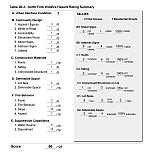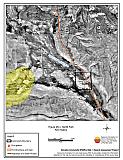28.0 North Fork
28.1 Risk and Hazard Assessment
North Fork is located in northwest Elko County on State Route 225, approximately 35 miles south of the Idaho border and sixty miles north of Elko. It is situated at an elevation of approximately 6,140 feet. The results of the community hazard assessment classified North Fork in the Moderate Hazard category (60 points). A summary of the factors that contribute to this hazard rating is included in Table 28-3. Primary factors include the lack of fire suppression resources, a high fuel load, and topography conducive to erratic fire behavior. The community boundary identified for this report is shown in Figure 28-1.
28.1.1 Community Design
The wildland-urban interface in North Fork has the characteristics of a classic interface condition: a clear line of demarcation exists where the Nevada Department of Transportation facility abuts wildland fuels. All four of the homes included in the assessment are on lots of one acre or less.
- Access: State Route 225 is the major transportation route through North Fork. The highway is at least 24 feet wide, paved, and has adequate turnaround space for fire suppression equipment.
- Signage: Street signs and residential addresses were not heavily weighted in the assessment for the four homes located along the highway in North Fork. While clear and visible street signs and residential addresses are important in locating homes during low visibility conditions that occur during a wildfire, it is unlikely that fire protection personnel would be unable to rapidly locate any home in the community threatened by wildfire.
- Utilities: All of the utilities are above ground. Power line corridors need proper maintenance to minimize wildfire damage to electric utilities and reduce the possibility that sparks could start a fire in adjacent vegetation.
28.1.2 Construction Materials
All of the homes observed in the interface area are built with non-combustible or highly fire resistant siding and roofing materials. One of the homes has an unenclosed architectural feature (a porch, deck, or balcony). Such features can create drafts and provide areas where sparks and embers can be trapped, smolder, ignite, and rapidly spread fire to the house.
28.1.3 Defensible Space
All of the homes meet the minimum recommended defensible space requirement to help protect the home from damage or loss during a wildfire.
28.1.4 Suppression Capabilities
Wildfire Protection Resources
North Fork has an inactive volunteer fire department. Table 28-1 lists the types of wildfire resources, cooperating partners, and equipment available for initial response to North Fork in the event of a reported wildfire. Additional resources are available from local, state, and federal agencies through mutual aid agreements as described in Section 4.1.1.
| Type of Equipment | Amount of Equipment | Cooperating Partner (Resource Location) |
|---|---|---|
| Type 4 Engine | 1 | Bureau of Land Management (Elko) |
| Type 3 Helicopter Air Attack Platform |
1 1 |
Bureau of Land Management (Elko Helibase) |
| Type 6 Engine Type 3 Engine Type I Water Tender |
1 1 1 |
Nevada Division of Forestry (Elko) |
| Type 6 Engine | 1 | US Forest Service (Mountain City) |
| Source: Sam Hicks, Nevada Division of Forestry Elko County Prevention Captain; Joe Freeland, Bureau of Land Management Elko Fire Management Officer; Kevin Hall, Nevada Division of Forestry Northern Region FMO; Tom Turk, Nevada Division of Forestry Northern Region Battalion Chief; Melody Asher, US Forest Service Zone FMO. | ||
Water Sources and Infrastructure
Water available for fire suppression in North Fork includes:
- Community wells.
- One water storage tank of unknown capacity.
- Local ponds, small lakes, and the North Fork Humboldt River.
28.1.5 Factors Affecting Fire Behavior
Fuels in the North Fork interface area consist primarily of moderately dense sagebrush and rabbitbrush with perennial grasses and some cheatgrass, estimated at two to three tons per acre Cheatgrass growth is dependent on annual moisture and will produce increased fuel volumes and elevate fuel hazard conditions in years of higher than average precipitation. Willows line riparian corridors. The terrain is mostly flat west and south of the community, and steep to the north and east, with some slopes reaching over a thirty percent grade. The prevailing wind direction is from the south/southwest. There is a history of afternoon thunderstorms and dry lightning strikes in the area.
28.1.6 Fire Behavior Worst Case Scenario
The worst-case scenario for a wildfire in the area surrounding North Fork would start from a dry lightning storm on a summer day in a year with normal to above normal precipitation and high annual grass and forb production. Multiple fire ignitions in the hills and mountains around the valley and strong erratic winds could push fires towards the valley floor. Surrounding agricultural lands somewhat mitigates the potential for hazardous fire behavior.
28.1.7 Ignition Risk Assessment
North Fork has a high risk of ignition. This determination is based on fire history in the area and the potential for increased fuel loading from annual grasses and forbs in high precipitation years. There is a moderate wildfire history in the public lands surrounding the community and a history of lightning strikes around the community. The primary risk of ignition in North Fork is lightning, although human caused ignitions are unpredictable and can occur at any time.
28.2 Risk and Hazard Reduction Recommendations
The responsibility to keep a community fire safe falls not only on the local fire protection district but also on the residents and local governments. The recommendations for the North Fork area focus primarily on the ongoing and additional efforts to create and maintain defensible space and on the community coordination and public education efforts that could be undertaken to enhance fire safety.
28.2.1 Defensible Space Treatment
Defensible space treatments are an essential first line of defense for residential structures. The goal of the treatments is to significantly reduce or remove flammable vegetation within a prescribed distance from structures. (Refer to Appendix E for the minimum recommended defensible space area). Defensible space reduces the fire intensity and improves firefighter and homeowner chances for successfully defending a structure against oncoming wildfire.
Property Owners Recommendations
- Remove, reduce, and replace vegetation around homes according to the guidelines in Appendix E. This area should be kept:
- Lean: There are only small amounts of flammable vegetation.
- Clean: There is no accumulation of dead vegetation or other flammable debris.
- Green: Existing plants are healthy and green during the fire season.
- Immediately dispose of cleared vegetation when implementing defensible space treatments. This material dries quickly and poses a fire hazard if left on site.
- Where cheatgrass has become dominant within the defensible space zone, areas should be mowed prior to seed maturity or treated with an application of a pre-emergent herbicide. Treatments may need to be repeated for several years to ensure that the seed bank of unwanted annual grass seeds has been depleted. Refer to Appendix E for a recommended seed mixture and planting guidelines that can be used in conjunction with cheatgrass removal.
- Remove all dead vegetation and other flammable materials a minimum of five feet from the exterior of the structure.
- Clear all vegetation and combustible materials around propane tanks for a minimum distance of ten feet.
- Mow or remove brush growing against fences in the community. The minimum distance for clearance should be ten feet in grass and 25 feet in brush.
- Maintain the defensible space as needed.
28.2.2 Fire Suppression Resources
North Fork VFD
- Coordinate with the Nevada Division of Forestry to reactivate the North Fork VFD, enhance recruitment of volunteers, establish training, and obtain personal protective equipment and fire suppression apparatus.
28.2.3 Public Education
A public education program that explains fire safe measures in clear and emphatic terms will have an impact on residents of the wildland-urban interface. Informed community members will be more inclined to make efforts to effectively reduce wildfire hazards around their homes and neighborhoods.
Property Owners
- Obtain copies of the publication “Living With Fire”. This publication is free of charge. Copies can be requested from the University of Nevada Cooperative Extension.
28.3 Summary of Recommendations
| Involved Party | Recommended Treatment | Recommendation Description |
|---|---|---|
| Property Owners |
Defensible Space | Remove, reduce, and replace vegetation around homes, equipment, and hay storage areas according to the guidelines in Appendix E. Maintain the defensible space annually. |
| Public Education | Obtain copies of the publication “Living With Fire.” | |
| North Fork VFD | Fire Suppression Resources | Coordinate with the Nevada Division of Forestry to reactivate the North Fork VFD, establish training, and obtain equipment. |
Table 28-3North Fork Wildfire Hazard Rating Summary |
 |
Figure 28-1North Fork Fire History |
 |
